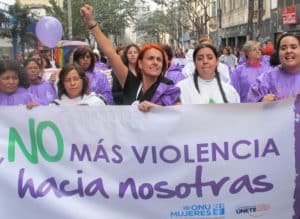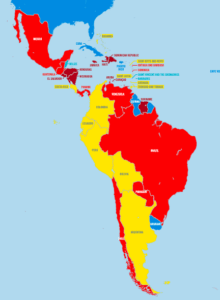In 2012, the death of a sixteen year old girl in the Dominican Republic caught the attention of human rights activists globally. She died because doctors refused to treat her leukemia on the grounds that providing her the chemotherapy would terminate her pregnancy and violate the country’s abortion laws.
The issues surrounding her death have largely been unchanged. Margaret Wurth is a senior researcher at Human Rights Watch focusing primarily on Latin America’s abortion laws. She spoke about an eleven year old girl from Argentina who experienced the same barriers on her reproductive health just this year.
“She was pregnant from rape and authorities delayed and repeatedly denied her and her families’ requests for a safe abortion. They delayed the procedure up until she had to have an emergency cesarean section, ultimately giving birth against her wishes. This is what happens when you live a place with high rates of violence against women and abortion is criminalized.” Wurth says that machista-based sexual violence is a significant issue undermining women’s reproductive health in a region where abortion largely remains criminalized.
Violence Against Women:

Every country in the Latin America and the Caribbean (LAC) region is party to two main international and regional human rights instruments, the Convention of the Elimination of all forms of Discrimination and Violence Against Women and the OAS Convention on the Prevention, Punishment and Violence Against Women. Despite these commitments to preventing gender based violence, Latin American countries fall behind in ensuring such violence does not occur.
The issue of sexual violence has become systemic largely due to the prevalence of machismo in the LAC region. As put by Ruiz, the sexual violence in the region is related directly to machista social norms that stipulate that women’s bodies belong to men as something that can be used and abused. The existing barriers women face on maintaining agency over their sexual health are exacerbated by the sexual violence they experience.
Latin American women face an extraordinary amount of physical abuse, sexual violence, and femicide. According to UN Women, 14 of the 25 countries with the highest rates of femicide are located in the LAC. The violence is not limited to murder, it includes physical abuse and sexual violence, most of which remains hidden at home. This kind of treatment is widespread and similar patterns of abuse can be commonly found throughout Latin America; women murdered by their partners, daughters raped by relatives, and women sexually abused by spouses. Ruiz and Manuel Balan, a professor on Latin American politics at McGill University, argued this sexual violence creates a culture in which women always have to be cautious due to a persistent fear in the back of their minds.
A study done by the Pan-American Health Organization (PAHO) found that across Latin American countries, between one in four to one in two women experienced violence from an intimate partner and anywhere from one in six to one in four women experience sexual violence from their partners. Additionally, the report found that women across Latin America are at a larger risk of experiencing sexual violence the younger they are, and observed that a notable amount of women’s first sexual encounters are forced onto them by relatives or partners.
Suriel and Ruiz attested to this reality. Suriel shared a story about a twelve year old girl in the Dominican Republic who became pregnant after her father “gifted” her to relatives. Ruiz shared another devastating story about a twelve year old girl in Nicaragua who was routinely raped by her father and after becoming pregnant, he poisoned and killed her.
Sexual Violence, and Women’s Health:
“If the connection between health, machismo, and security is not made, it will be very difficult to improve the lives of women and girls,” Ruiz says. Machismo has strong impacts on women’s sexual health, whether it be through outright rape or impacting a woman’s ability to confidently give consent. Putting the sexual violence into context makes enduring the abuse all the more challenging since women face significant barriers that their limit control over their reproductive health.
The LAC region is home to some of the most restrictive abortion laws in the world. For example, the Dominican Republic, Nicaragua, El Salvador, and Honduras all criminalize abortions under all circumstances, including rape or to save a woman’s life. El Salvador and Honduras further hamper women’s reproductive health by prohibiting public access to emergency contraception.
“Women face violence and harassment but then the law serves as an additional form of discrimination and a barrier” infringing on their health,” Wurth says, so that even after women’s bodies are sexually violated, they lack of control over their bodies due to deficient reproductive services.
Shoddy provision of emergency contraception, criminalized abortion, and inadequate treatment by healthcare providers forces women to resort to dangerous avenues to try to maintain agency over their reproductive health, Wurth says. “[Women are] in a position of choosing between containing a pregnancy from rape, which international human rights bodies have said equates to torture, or finding a way to have a clandestine abortion that puts a risk on their health and lives.”
Without adequate access to emergency contraception, women’s choices are limited to spending money on underground, expensive medications or become pregnant. For example, Ruiz explained how one would have expected that, following sexual violence, a woman might arrive at a hospital and, among other services, be given emergency contraception to prevent a pregnancy. She says this is not always the case, especially in places like Honduras where the pill is illegal. Legal or not, the urgency of the situation is taken advantage of by pharmacies or illicit providers who inflate the cost of these pills. Women may not be getting what they paid for and thus remain pregnant, and they may also have to deal with possible side-effects from whatever other drug they took.

Without reliable access to medically supervised abortions, women to turn to run-down practices without proper equipment, training, or sanitation. Wurth shared the experience of one woman in the Dominican Republic who “turned to the first place she could find for help which ended up being a filthy clinic.” She explained how these procedures are often compounded with traditional remedies such as teas or herbs which can lead to pain, bleeding, and infections. The conditions in which these abortions are done can leave women botched with lifelong complications and even result in death. According to the World Health Organization (WHO), around three out of four abortions that occur in Latin America are unsafe and risk infection, hemorrhaging, or damaging internal organs.
Even in countries with looser abortion laws, women still face strong barriers to reproductive health services. The cost and accessibility of these services, especially for rural women, can turn women towards underground practices. Even where laws permit abortions, it is not unheard of to be refused, shamed or mistreated by health care providers as a form of punishment.
Wurth says that healthcare providers often service botched abortions “without giving pain relief or anesthesia, equating to a form of abuse at the hands of practitioners that is perceived as a form of punishment.” She said that the stigmatization around abortion is so high that even women who are thought to have had a clandestine abortion are abused.
She told me about a woman who had an ovarian cyst that burst. “She was in tremendous pain, requiring urgent medical attention, and the healthcare provider assumed she had induced a clandestine abortion and made her wait, leaving her in pain.”
The fear of being mistreated by healthcare professionals turns women away from safe practices back to covert drugs or procedures. Ruiz talked about women who go through underground abortions and suffer complications yet refuse to go to the hospital because they will either not be treated, be mistreated and shamed by the staff or even arrested.
Even outside the context of abortion services, machismo affects reproductive health. Ruiz says women diagnosed with a sexually transmitted infection often tell their doctors, “I cannot tell my partner. If I tell him this I will have a lot of problems so I cannot do anything you are telling me.”
Ruiz noted that many men do not want to use condoms and the power imbalance between men and women makes women feel unable to tell their partners to use them. Even after diagnosis and despite doctor’s recommendations, Ruiz said women still have a hard time telling their partner to use condoms out of fear. Even when women have consensual relations, they face limitations in asserting control over their sexual health.
What Needs to Change?
Unfortunately, gaining legal access to reproductive health services and changing harmful gender norms are not issues that can be addressed in a day. Wurth argued that striving for legalization for abortion must be at the center of change. Though they are optimistic, both Suriel and Ruiz agreed that the prospects of full legalization of abortion in the near future are slim. Without the promise that legal barriers will be lifted soon, Suriel and Ruiz agreed that giving women more agency over their bodies requires abandoning machista norms that perpetuate inequality, submission, and violence against women.
“As with anything that’s structural, machista norms will take a long time to change,” Balan said, adding that efforts “cannot stop at naming and shaming men. Approaching machismo entails a bigger picture.”
He argues that change is centered on completely deconstructing machismo and the existing gender roles for both men and women. Balan highlighted the growing notion of hombres deconstruidos, or men who have “deconstructed” themselves or abandoned macho culture. “People poke fun at ‘desconstrucion’ but it is key for both men and women.”

Photo: Women in Black, Uruguay
What is the Role of Sexual Education?
The reality is that the deficient sexual education in LAC remains a missed opportunity for changing harmful gender norms. Many countries have flawed sexual education curriculums, if one at all, “leaving adolescent girls and boys without any comprehensive information on their sexual health,” Wurth says.
“Ensuring that, from a young age, adolescents are given scientifically accurate, rights based information about their bodies, consent, and relationships is a way to broadly change gender norms and empower people,” she says. Improving sexual education in accordance to UNESCO’s Comprehensive Sexuality Education Guidelines, for example, would do a number of things. The guidelines take the approach that comprehensive sexual education has the potential to increase safe sex practiced among adolescents and decrease the risk of pregnancy for young women. Benefits would go “beyond health outcomes including: preventing and reducing gender-based and intimate partner violence and discrimination; increasing gender equitable norms, self-efficacy and confidence; and, building stronger and healthier relationships.”
This would be a major step in breaking the cycle of passing on machista norms that perpetuate sexual violence. Mmachista values are introduced to kids from a young age, whether it be the music they listen to or the familiar interactions they pick up at home. Teaching adolescents about what consent means, and how to protect their bodies and have safe, consensual sexual relationships when they’re ready and on their own terms” can therefore combat machista norms in future generations.
Starting sexual education from a young age and building on it incrementally, children can have a broad understanding of their bodies and where to go to seek services when they need help. Wurth uses the example of misoprostol, a medication available in many countries over the counter to treat stomach ulcers which can induce an abortion. “If women and girls have good information about safer ways to end a pregnancy, about the dosage, and the signs to seek medical attention,” she says, women wouldn’t have to resort to the first seedy place they find for help.
What is the Role of the Private Sector?
Corporations influence societal norms due to their reach through advertisements and marketing, especially with their control of media outlets, television, and the music industry.
The messages promoted in advertisements resonate with people, whether they be positive or not. Companies often neglect their responsibility and do not realize how they can reinforce gender inequality and violence. An example Ruiz used was the reggaeton industry, a popular genre of music with a massive reach whose messages preserve the harmful gender norms that normalize sexual misconduct. She argued that if television, music, or corporate advertising continues to sexualize and objectify women, the way people perceive gender relations will not improve. Changing the ideals surrounding the role of men and women requires, at the least, that corporations do not reinforce negative norms.
Ruiz talked about the powerful impact corporations can have in depicting women as strong, diverse and powerful people. By promoting images or messages of women who are capable and independent, corporations empower women to believe they have agency and contributes to the gradual transition away from harmful gender roles that stipulate women are submissive and dependent on men.
Many companies are beginning to realize this and have started framing women in an empowering way. Athletic companies such as Under Armour and Nike are highlighting powerful female athletes, breaking the stereotype that women are fragile or weak. Companies like Dove are highlighting the differences among women, moving away from the idea that being a beautiful woman is restricted to a certain skin color or body type. Numerous corporations have launched campaigns to show women they are as capable as men to become leaders by promoting female education and entrepreneurship.
This, however, is not enough to deconstruct machismo, Balan says. Empowering women needs to be coupled with educating men and promoting messages that normalize deviating from machista norms. Balan pointed out an exemplar advert done by Sprite in the context of Argentine pride. The message moves beyond empowering women or naming and shaming men and completely challenges current notions of gender, identities, and familiar roles. Balan says messages like these are the ones that will contribute to gradually deconstructing and replacing machista norms.
“Young people are leading important change,” Ruiz says. “Men are beginning to talk to men, women are talking to women and these norms are gradually being challenged but we need governments, companies and other actors to sustain these social movements to create change.”
- Damaris Ruiz, Coordinator for women’s rights in the LAC, Oxfam.
- Margaret Wurth, Senior researcher, Human Rights Watch.
- Manuel Balan, Associate professor, Dept. of Political Science, McGill University.
- Patricia Suriel, Executive director, Mariposa Foundation
Efforts to contact the following corporations for comment on their role in women’s health initiatives were unsuccessful: Unilever/Dove, Johnson & Johnson, Procter & Gamble


